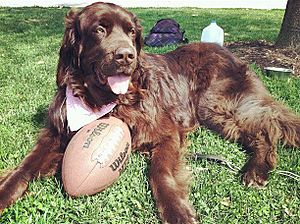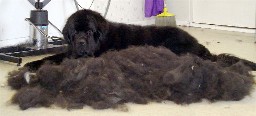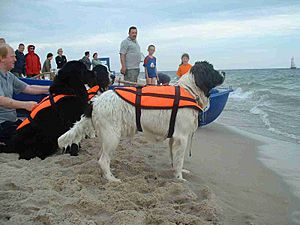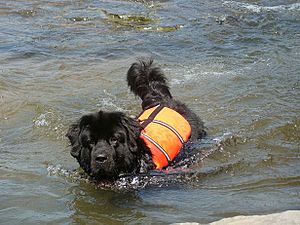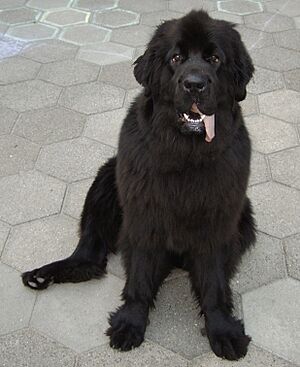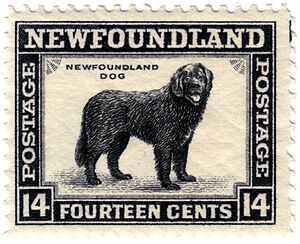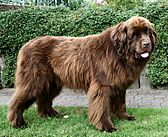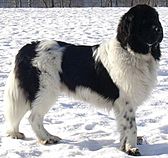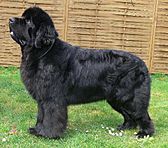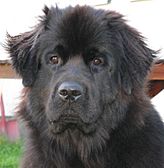Newfoundland dog facts for kids
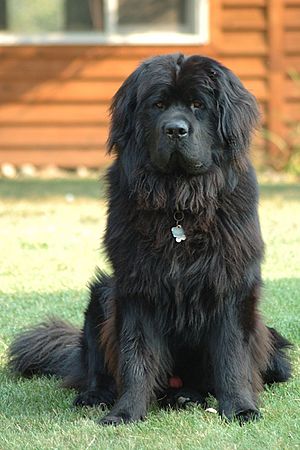
Newfoundland
|
|||||||||||||||||||||||||||||||||
| Origin | Island of Newfoundland, modern-day Canada | ||||||||||||||||||||||||||||||||
|---|---|---|---|---|---|---|---|---|---|---|---|---|---|---|---|---|---|---|---|---|---|---|---|---|---|---|---|---|---|---|---|---|---|
|
|||||||||||||||||||||||||||||||||
|
|||||||||||||||||||||||||||||||||
| Notes | Provincial mammal of Newfoundland | ||||||||||||||||||||||||||||||||
| Domestic dog (Canis lupus familiaris) | |||||||||||||||||||||||||||||||||
The Newfoundland is a very large working dog. These dogs can be black, brown, grey, or white with black patches. Long ago, in Newfoundland, only black and white-and-black dogs were seen as true members of the breed. Newfoundlands were first bred to help fishermen in Newfoundland.
These dogs are famous for their huge size, smart minds, amazing strength, calm personalities, and loyalty. They are excellent at water rescue and lifesaving. This is because they have strong muscles, a thick double coat, webbed paws, and are great swimmers.
Contents
About Newfoundlands
What They Look Like
Newfoundlands, often called 'Newfs' or 'Newfies', have webbed paws. Their fur coat is also water-resistant. Male Newfoundlands usually weigh between 65 and 80 kilograms (143–176 pounds). Females are a bit lighter, weighing 55 to 65 kilograms (121–143 pounds). This makes them "Giant" dogs. Some Newfoundlands have weighed over 90 kilograms (198 pounds)! The biggest one ever recorded weighed 120 kilograms (265 pounds) and was over 1.8 meters (6 feet) long from nose to tail. They can grow up to 76 centimeters (30 inches) tall at the shoulder.
The American Kennel Club (AKC) says Newfoundlands can be black, brown, grey, or white-and-black. The white-and-black pattern is sometimes called "Landseer." This name comes from the artist Sir Edwin Henry Landseer. He painted many pictures of these dogs. Other colors are possible, but they are not rare or more special.
Newfoundlands have very large bones, which makes them heavy. Their strong muscles give them the power to handle rough ocean waves. These dogs have huge lungs, so they can swim very far. Their thick, oily, and waterproof double coat keeps them warm in icy water. This double coat needs a lot of grooming and sheds a lot. Their droopy lips can make them drool, especially when it's hot.
In the water, the Newfoundland's big webbed paws help it push through the water. They don't just "dog paddle." Instead, they move their legs in a powerful down-and-out motion. This gives them more strength with each stroke.
Their Personality
The Newfoundland is famous for being calm, gentle, and strong. They are very loyal and make great working dogs. Because of this, they are often called "the gentle giant." Dog clubs around the world describe them as having a sweet personality. They usually have a deep bark and are easy to train if you start when they are young.
Newfoundlands are wonderful with children. However, because they are so big, they might accidentally lean on or knock over small kids. They are also great therapy dogs and are sometimes called the "nanny dog." A famous Newfoundland, "Nana," was the guardian dog in J. M. Barrie's Peter Pan. Newfoundlands generally get along well with other animals. But their size means they need good training to avoid problems.
A Newfoundland's kind and sweet nature is so important that it's written in the rules for the breed. Dogs that are aggressive are not allowed in shows and should not be used for breeding. The rules in the United States say that "Sweetness of temperament is the hallmark of the Newfoundland; this is the most important single characteristic of the breed."
Staying Healthy
Newfoundlands can have some health issues. They are prone to hip dysplasia, which means their hip joint doesn't form correctly. They can also get elbow dysplasia. Another problem is cystinuria, a genetic issue that causes stones to form in their bladder.
A heart problem called subvalvular aortic stenosis (SAS) is also common. This is a heart defect that can cause sudden death at a young age. Newfoundlands usually live to be 8 to 10 years old. Some can even live up to 15 years.
History of the Breed
Where They Came From
Scientists have studied the genes of Newfoundlands. They found that these dogs are related to the Irish Water Spaniel, Labrador Retriever, and Curly-Coated Retriever.
The Newfoundland dog was first bred to work with fishermen on the island of Newfoundland.
In the 1880s, fishermen and explorers from Ireland and England came to Newfoundland. They saw two main types of working dogs there. One was a big, strong dog with long fur, which was the Newfoundland we know today. The other was a smaller, active dog with smooth fur, called the St. John's water dog. The St. John's water dog later became the ancestor of modern retrievers. Both types of dogs helped pull fishing nets. The larger Newfoundland also pulled carts and other heavy gear.
Their Reputation
Newfoundlands had many different jobs. Many stories tell of the brave things Newfoundlands have done in adventures and rescues. Over the past 200 years, artists have shown these dogs in paintings, sculptures, and other art. One famous Newfoundland was a dog named Seaman. He traveled with American explorers Lewis and Clark on their famous journey.
The breed became popular in the United Kingdom. However, their numbers dropped a lot during World War I and World War II. Since the 1950s, their numbers have grown steadily. Even though they are big and love mud and water, many people still want them as pets.
Water Rescue Skills
Newfoundlands are known for their strong desire to rescue people from water. It is said that one Newfoundland once helped save 63 sailors from a shipwreck! Today, dog clubs in the United States hold demonstrations to show how Newfoundlands rescue people. They also offer classes to train these dogs for water rescue. In St. John's, many boat tours have a Newfoundland dog on board. They are there for charm and also for safety.
Here are some famous water rescues by Newfoundlands:
- An unnamed Newfoundland is said to have saved Napoleon Bonaparte in 1815. During his escape from an island, rough seas knocked Napoleon overboard. A fisherman's dog jumped in and kept Napoleon afloat until he was safe.
- In 1828, Ann Harvey, her father, her brother, and a Newfoundland named Hairyman saved over 160 Irish immigrants. Their ship, the Despatch, was wrecked.
- In 1881, in Melbourne, Australia, a Newfoundland named Nelson helped rescue a cab driver named Thomas Brown. He was swept away by floodwaters. Nelson's copper dog collar is now in the National Museum of Australia.
- In the early 1900s, a dog believed to be a Newfoundland saved 92 people from the SS Ethie. The ship was wrecked off Newfoundland during a blizzard. The dog brought a rope from the ship to the shore. Everyone on board was then able to get to safety, even a baby in a mailbag.
- In 1995, a 10-month-old Newfoundland named Boo saved a man who couldn't hear. The man was drowning in the Yuba River in California. Boo saw the struggling man and dove into the river. He grabbed the man by the arm and pulled him to safety. Boo had no special training for water rescue.
Related Breeds
Newfoundlands share many features with mastiffs and Molosser-type dogs. These include strong legs, large heads, wide snouts, thick necks, and a very sturdy body. Many St. Bernard dogs have Newfoundlands in their family history. Newfoundlands were introduced to the St. Bernard breed in the 1700s. This happened when a disease threatened the St. Bernard population. Newfoundlands also share traits with many livestock guardian dog breeds, like the Great Pyrenees.
Because of their strength, Newfoundlands were used to create the Leonberger breed. Leonbergers were also good at water rescue. Newfoundlands were also part of the breeding for the Moscow Water Dog. This breed was an attempt by Russia to create a lifesaving dog, but it didn't work out well.
Famous Newfoundlands
Napoleon the Wonder Dog
A famous all-black Newfoundland named "Napoleon the Wonder Dog" was a star in Van Hare's Magic Circus. This was one of England's first circus acts, starting in 1862. Napoleon performed all over Europe. The circus owner, G. Van Hare, also trained other Newfoundlands to do a steeplechase with baboons dressed as jockeys riding them. But Napoleon was his favorite.
Napoleon the Wonder Dog became very popular in London. He could spell his own name and the Prince of Wales's name with letters. He would also spell "God save the Queen." He could play cards and do magic tricks. He even performed circus acts like a trick horse, dancing to music and jumping over bars and through balloons.
Napoleon the Wonder Dog died at 11 years old because of a circus accident. His death was reported in many British newspapers. The Sheffield Daily Telegraph mentioned his passing on May 5, 1868. It said he was a "noble specimen of the Newfoundland breed" and a "highly-trained animal." His body was preserved by a famous naturalist.
Other Famous Newfoundlands
- Bashaw (Matthew Cotes Wyatt): This was the favorite dog of the Earl of Dudley. He inspired a sculpture at the Victoria and Albert Museum in London.
- Bilbo: A lifeguard Newfoundland dog on Sennen beach in Cornwall, England. He is known for saving three lives.
- Boatswain: The pet of English poet Lord Byron. Byron wrote a poem about him called "Epitaph to a Dog". Byron tried to help Boatswain when he got rabies, but the dog died. Byron built a monument for him.
- Bouncer: This dog was a gift to the Duke and Duchess of Cornwall and York (later King George V and Queen Mary) from the children of Newfoundland in 1901.
- Frank: The unofficial mascot of the Orphan Brigade during the American Civil War.
- Gander: A World War II mascot for the Royal Rifles of Canada. He was killed in action during the Battle of Hong Kong. He carried a grenade away from wounded soldiers. For his bravery, he received the PDSA Dickin Medal in 2000. There is a statue of him in Gander, Newfoundland.
- Rigel: This dog was thought to be the pet of an officer on the RMS Titanic. The officer died when the ship sank. But Rigel swam for three hours next to a lifeboat until it was rescued. Rigel is famous for alerting the rescue ship, the RMS Carpathia, to the survivors.
- Sable Chief: The World War I mascot of the Royal Newfoundland Regiment.
- Seaman: This dog traveled with explorer Meriwether Lewis on the Lewis and Clark Expedition from 1804 to 1806. His collar tag said he was "The greatest traveller of my species."
- Swansea Jack: A famous rescue dog from Wales. He was identified as a Newfoundland, but looked more like a modern Flat-Coated Retriever.
Gallery
-
A Landseer
Images for kids
See also
 In Spanish: Terranova (perro) para niños
In Spanish: Terranova (perro) para niños



